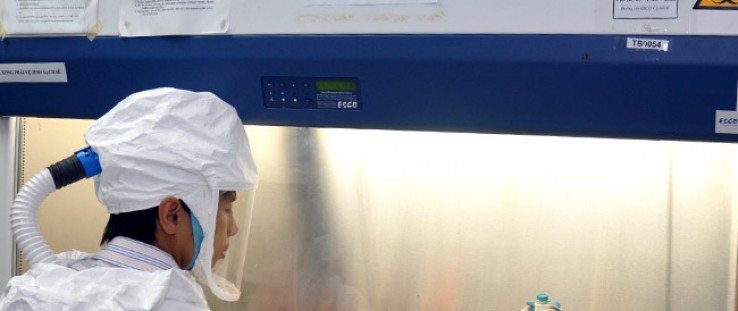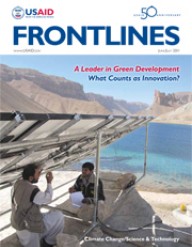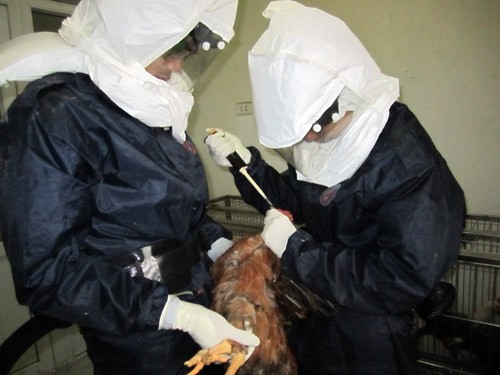 USAID funding has enabled a network of national and regional laboratories to detect and monitor strains of H5N1 and other viruses in safe conditions.
Richard Nyberg/USAID
USAID funding has enabled a network of national and regional laboratories to detect and monitor strains of H5N1 and other viruses in safe conditions.
Richard Nyberg/USAID
 USAID funding has enabled a network of national and regional laboratories to detect and monitor strains of H5N1 and other viruses in safe conditions.
Richard Nyberg/USAID
USAID funding has enabled a network of national and regional laboratories to detect and monitor strains of H5N1 and other viruses in safe conditions.
Richard Nyberg/USAID
HANOI— Avian influenza may have escaped the frightening headlines of the last few years, but it is far too early to turn the page on bird flu. Just ask the scientists in Vietnam. Right now they have their hands full figuring out how to beat back a vaccine-resistant strain of virus currently killing chickens and ducks in scattered pockets of the north.
Now, as over the past six years, USAID and the United Nations’ Food and Agriculture Organization (FAO) are assisting Vietnam with added resources and technical expertise.
The country has come a long way since the first case of highly pathogenic avian influenza (HPAI) was detected in 2003. Dr. Nguyen Ngoc Tien of Vietnam’s Department of Animal Health told a scientific conference sponsored by USAID in June that, over the past eight years, authorities have had to cull 63 million poultry in 40 of the country’s 63 provinces.
Of the 119 human cases of the H5N1 virus reported in Vietnam since 2003, 59 have been fatal. While Vietnam is widely considered to be a model in terms of its response to bird flu, globally it ranks third behind Indonesia and Egypt in human cases and deaths.
As of June 10, in 15 countries around the world, there were 556 human cases and 325 deaths from the disease. Other countries where avian flu is currently considered endemic include Bangladesh, China, and India.
Most of the Vietnam’s infection over the past eight years have come during waves of outbreaks around Tet, the annual Lunar New Year celebrations in January or February when millions of people, chickens, and ducks are on the move, often closely together, making it easy for viruses to spread.
“We are trying to contain avian influenza on a small scale in scattered outbreaks,” said Dr. Hoang Van Nam, director general of the Department of Animal Health. “With continued donor support, we think we can maintain our position and gain more results, setting our priorities on research and other activities for influenza control in the country.”
This year, however, just as the Government of Vietnam was about to launch its fourth nationwide poultry vaccination campaign targeting the country’s 290 million chickens and ducks, experts at the National Center for Veterinary Diagnosis (NCVD) detected a reemerged clade 2.3.2—a specific virus strain characterized as highly pathogenic and one of 10 virus groups detected in Vietnam over the years.
Many of the people who study and monitor clades and the movement of viruses in Vietnam are virologists at the NCVD and eight regional laboratories. Since 2006, they have received funding and technical support from USAID and the FAO.
After the discovery of the new virus strain, NCVD and FAO experts determined that vaccines currently used in the country were ineffective against some viruses of the 2.3.2 strain. It has prompted Vietnam to postpone new vaccinations until an effective vaccine can be developed, although the government still has 50 million doses of the current vaccine ready if it has to deal with outbreaks in the south (where the vaccine is still considered effective).
“We know that the clade shift that everyone has been talking about will be a bit of a game-changer,” said Tim Meinke, USAID’s senior infectious diseases adviser. USAID began supporting avian and pandemic influenza (API) programs in Vietnam in 2005, and since then has provided over $40 million in assistance and technical support.
This year, USAID is working with international reference laboratories to find an effective vaccine that can then be tested by the NCVD. USAID and FAO are also currently wrapping up a large-scale, two-year operational research project at the provincial level to identify best practices and policy guidance on a safe, effective, and sustainable poultry vaccination strategy to limit the spread of bird flu. This comes as Vietnam finalizes its 2011-2015 strategy to prevent and control HPAI and other emerging pandemic threats.
“This USAID-funded project gives us evidence-based research to deliver a new vaccination strategy to help control HPAI as well as minimize the cost of vaccine for the government and decrease human resources for veterinary services required for organizing the vaccination campaigns,” said Dr. Nam.
Battling a Virus
In Vietnam, once a farmer discovers that several birds or ducks have died, a specimen of the infected animal makes its way through a chain of command, ending up in the national or regional labs.
“Checking the virus is very important to us because our center’s responsibility is to monitor how the virus is changing,” said Nguyen Tung, deputy director of the national diagnosis center. “We have to know if it is an old virus or a new virus, if the virus is lethal or non-lethal, and if the vaccines used against this virus are effective or not.”
He explained that once a virus is determined to be highly pathogenic, it undergoes further characterization. The center’s scientists also monitor the vaccines through “challenging” trials— infecting vaccinated birds with a virus such as clade 2.3.2.
“After we conducted work on virus characterization and animal studies, we found that we have one virus that is really causing problems for our national mass vaccination program. Our current best vaccine cannot provide good protection for the birds even though they have been fully vaccinated,” said Tung.
He said the support they have received through the ongoing USAID project was important to the national lab network. “If you go back six years, our capacity to fight avian influenza H5N1 was very limited. Now, with a lot of investment from USAID and technical support through FAO, we have a much updated laboratory network that we can use to perform tests to identify and combat the H5N1 virus. We also update our knowledge to understand better about the virus and animal diseases.”
Standing shoulder to shoulder with Tung is FAO virologist Ken Inui. “We are fighting against H5N1, and when you are fighting, you need to know the enemy very well to win,” he said. “That is what we are doing. Virus characterization is part of how to know the clade, which is our enemy. You have to investigate a lot of possibilities before attacking.”
For now, much of the focus will be on defeating clade 2.3.2.
“The whole world is looking at Vietnam,” said Santanu Bandyopadhyay, a senior technical officer at FAO. “Certainly people are very interested in what Vietnam does next in its control and vaccination efforts.”










Comment
Make a general inquiry or suggest an improvement.